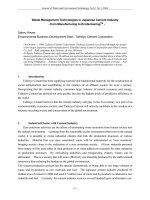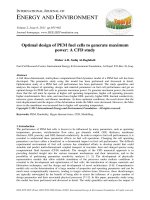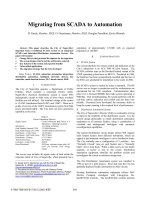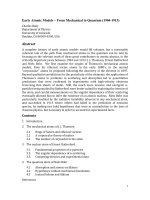process plant design project management from inquiry to acceptance
Bạn đang xem bản rút gọn của tài liệu. Xem và tải ngay bản đầy đủ của tài liệu tại đây (2.7 MB, 205 trang )
Frank Peter Helmus
Process Plant Design
Further Reading
Vogel, G. H.
Process Development
From the Initial Idea to the
Chemical Production Plant
2005
ISBN: 978-3-527-31089-0
Wiley-VCH (ed.)
Ullmann’s Chemical
Engineering and Plant
Design
2 Volumes
2005
ISBN: 978-3-527-31111-8
Wiley-VCH (ed.)
Ullmann’s Processes and
Process Engineering
3 Volumes
2004
ISBN: 978-3-527-31096-8
Zlokarnik, M.
Scale-up in Chemical
Engineering
Second, Completely Revised and
Extended Edition
2006
ISBN: 978-3-527-31421-8
Frank Peter Helmus
Process Plant Design
Project Management from Inquiry to Acceptance
Translated by Christine Ahner
The Author
Prof. Dr Ing. Frank Peter Helmus
University of Applied Sciences Osnabrück
Engineering + Computer Science
Albrechtstr. 30
49076 Osnabrück
Germany
All books published by Wiley-VCH are carefully
produced. Nevertheless, authors, editors, and
publisher do not warrant the information
contained in these books, including this book, to
be free of errors. Readers are advised to keep in
mind that statements, data, illustrations,
procedural details or other items may
inadvertently be inaccurate.
Library of Congress Card No.:
applied for
British Library Cataloguing-in-Publication Data
A catalogue record for this book is available from
the British Library.
Bibliographic information published by the
Deutsche Nationalbibliothek
Die Deutsche Nationalbibliothek lists this
publication in the Deutsche Nationalbibliografi e;
detailed bibliographic data are available on the
Internet at <>.
© 2008 WILEY-VCH Verlag GmbH & Co.
KGaA, Weinheim
All rights reserved (including those of translation
into other languages). No part of this book may
be reproduced in any form – by photoprinting,
microfi lm, or any other means – nor transmitted
or translated into a machine language without
written permission from the publishers.
Registered names, trademarks, etc. used in this
book, even when not specifi cally marked as such,
are not to be considered unprotected by law.
Typesetting SNP Best-set Typesetter Ltd., Hong
Kong
Printing Betz-Druck GmbH, Darmstadt
Bookbinding Litges & Dopf GmbH,
Heppenheim
Printed in the Federal Republic of Germany
Printed on acid-free paper
ISBN: 978-3-527-31313-6
This book is dedicated to my three daughters Svenja, Tabea and Merle.
Contents
Preface XVII
Acknowledgements XIX
1 Introduction 1
1.1 General remarks on process plant design 1
1.2 Project 2
1.3 Demands on project engineers 6
1.4 Overview of activities 8
2 Project Planning 13
2.1 Operator 13
2.1.1 Product development 14
2.1.2 Plant type 14
2.1.2.1 Location/kind of premises 15
2.1.2.2 Capacity/availability/lifespan 16
2.1.2.3 Degree of automation 17
2.1.2.4 Legal requirements 17
2.1.3 Costs 18
2.1.3.1 Investment 19
2.1.3.2 Operating costs 21
2.1.4 Inquiry/invitation to tender 23
2.1.5 Project controlling 27
2.2 Plant manufacturer 28
2.2.1 Risk analysis 28
2.2.2 Basic engineering 30
2.2.2.1 Process development 30
2.2.2.2 Balancing 32
2.2.2.3 Basic and process fl ow diagram 34
2.2.2.4 Materials concept 36
2.2.2.5 Main apparatus 42
2.2.2.6 Layout 45
2.2.3 Quotation 48
VII
Process Plant Design. Project Management from Inquiry to Acceptance. Frank Peter Helmus
Copyright © 2008 WILEY-VCH Verlag GmbH & Co. KGaA, Weinheim
ISBN: 978-3-527-31313-6
VIII Contents
2.2.3.1 Quotation price 48
2.2.3.2 Optimization 49
2.2.3.3 Contract negotiations 53
3 Contract 55
3.1 General 56
3.1.1 Defi nitions 56
3.1.2 Order basis 56
3.1.3 Regulations 57
3.1.4 Labour employment 58
3.1.5 Subcontractors 58
3.1.6 Project documentation 59
3.2 Technical part 60
3.2.1 Contractor’s scope of supply and services 60
3.2.2 Employer’s scope of supply and services 62
3.3 Commercial part 63
3.3.1 Deadlines/penalties 63
3.3.2 Warranties/penalties 66
3.3.3 Defects/acceptance 67
3.3.4 Prices/terms of payment/bonds 69
3.3.5 Alterations/claims 70
3.3.6 Termination/suspension 74
3.3.7 Insurance 75
3.3.8 Secrecy 76
3.3.9 Severability clause 77
3.3.10 Coming into effect 77
3.3.11 Signature policy 78
4 Project execution 81
4.1 Project organization 81
4.1.1 Project structures 82
4.1.2 Systematics 90
4.1.2.1 Project manual 90
4.1.2.2 Correspondence system 92
4.1.2.3 Revision service 93
4.1.3 Cost monitoring 95
4.1.4 Time scheduling/monitoring of dates 96
4.1.5 Computers in plant manufacturing 97
4.2 Approval planning 102
4.3 Component procurement 103
4.3.1 Vessels 110
4.3.2 Pumps 111
4.4 Piping and instrumentation diagrams 117
4.5 E/MC-technology 135
4.5.1 Electrical engineering 136
Contents IX
4.5.2 Measurement engineering 137
4.5.3 Control engineering 143
4.6 Layout and building design 147
4.6.1 Layout design 147
4.6.2 Building design 150
4.7 Piping planning 154
4.8 Documentation 161
4.9 Erection 165
4.9.1 Excavation and civil works 166
4.9.2 Component assembly 167
4.9.3 Pipe assembly 169
4.9.4 Assembly E/MC technology 171
4.9.5 Insulations 172
4.9.6 Plant marking 173
4.10 Commissioning 175
4.10.1 Training 176
4.10.2 Cleaning 176
4.10.3 Pressure tests 177
4.10.4 Functional tests 178
4.10.5 System tests 179
4.10.6 Cold commissioning 180
4.10.7 Warm commissioning 180
4.11 Warranty run/acceptance 182
Index 183
Preface
Undertaking the design, erection and commissioning of process
engineering plants requires a whole host of knowledge areas. Moreover, apart
from this knowledge, project engineers also need to be in command of a range
of so - called “ soft skills ” in order to communicate with engineers involved
in the project in multi - disciplinary ways. Furthermore, project engineers are
under enormous pressures of time and cost due to the strong international
competition. Finally, a lot of experience is required in the business of plant
engineering and construction. Some companies ’ tendency towards early
retirement entails great loss in experience values. To make matters worse, some-
times those “ old hands ” are not given the opportunity to transfer their knowledge
to young engineers. Thus, the mistakes of former generations continue to be
repeated.
This fl ood of demands, however, should by no means act as a deterrent. On the
contrary: The fascination of process plant engineering needs to be conveyed. Try
imagining how it feels if after two or three years of hard project - related team work,
a process plant, planned and erected with consideration having been given to the
latest process - engineering, environmental and safety - engineering insights is
fi nally realized. This is something you can show your kids and say: “ I had a share
in it! ”
Of course, mistakes are sometimes made during the execution of a project. The
crucial point, however, is how to avoid big and thus really expensive mistakes.
Therefore, in this book, with the help of examples, many possibilities for error
that may arise during the execution of a project will be described.
This book is intended to address beginners and to give them an overview of the
activity fl ow involved in process plant engineering. The technical details are not
exhaustive, but are rather intended to give a broad coherent view. Process engi-
neers are also required to have a certain basic knowledge of economics, and this
is given in Chapter 3 , “ Contract ” , in terminology which, I hope, will be compre-
hensible to engineers.
XI
Process Plant Design. Project Management from Inquiry to Acceptance. Frank Peter Helmus
Copyright © 2008 WILEY-VCH Verlag GmbH & Co. KGaA, Weinheim
ISBN: 978-3-527-31313-6
In general, more importance is attached to clear and understandable rather than
technical and dry language. Therefore, many terms are derived from industry
terms and jargon.
Prof. Dr Ing. Frank P. Helmus
University of Applied Sciences Osnabr û ck
Faculty of Engineering and Computer Sciences
PO - Box: 1940
D - 49009 Osnabr ü ck
Visitors ’ Address: Albrechtstr. 30
XII Preface
I would like to express my thanks to all those involved in this book project. My
special thanks go to the following for their help and support:
• Gerhard Lohe and Petro Sporer for their numerous ideas
and their proofreading.
• Mr and Mrs Norber and Ulrike Sommer for proofreading.
• Mrs Stefanie Lange for her support in Chapter 3, “Contract”.
• Jörg Buchholz for his cooperation.
• Jürgen Nahstoll for his support regarding the topic of
“Maintenance”.
• All colleagues of the faculty of Materials and Processes for
various suggestions and bibliographical references.
• Martin Reike, my colleague at the Department for
Mechanical Engineering, for his support in Chapter 4.
section 4.5, “E/MC-Technology”.
• My colleague Wolfgang Seyfert of the Department for
Economy for a lot of information in the fi eld of project
management.
• Karin Sora and Mr Münz for their assistance and support on
the part of the publisher.
• All companies providing original photos, tables etc.
• Students contributing to this book within the framework of
student research projects.
Process Plant Design. Project Management from Inquiry to Acceptance. Frank Peter Helmus
Copyright © 2008 WILEY-VCH Verlag GmbH & Co. KGaA, Weinheim
ISBN: 978-3-527-31313-6
Acknowledgements
XIII
Introduction
1.1
General remarks on process plant design
In process plants, source materials (reactants) are converted into merchantable
products. Source materials and products may be gaseous, liquid or solid sub-
stances or even mixtures of these different states (suspensions, particulates etc.)
Products may be intermediate or end products which are being processed step by
step. The result is a whole host of possible problems or types of plants that solve
these problems. The following list shows at least some typical products of process
plants and their lines of business:
• chemistry: paints, plastics, fi bres, fertilizers etc.
• pharmaceutics: drugs
• cosmetics: creams, lotions, cosmetic products etc.
• r e fi neries: fuels, basic products for chemistry, lubricants etc.
• building materials: cement, sand, gravel etc.
• food industry: fats, oils, cereals, sugar etc.
• coal: mining and processing of coal
This book deals with the activities arising during the phase of design, construc-
tion and start - up of process plants. Here, the emphasis is on process plants, since,
in comparison with production plants, totally different planning instruments (e.g.
CAD - systems) and steps (e.g. pipe design) are required. The activities are, as far
as possible, described chronologically, beginning with the product idea up to the
acceptance of a successfully commissioned plant. In order to keep the scope
of this book within reasonable limits it cannot go into each and every detail,
but instead refers to secondary literature. Importance is attached to practical
orientation. Since, depending on the company, procedures regarding project
management are often very different not all procedural methods can be taken
into account. The focus is rather on the imparting the understanding of basic
structures.
The book has mainly been written for students of process engineering and
chemical engineering as well as professional newcomers of these disciplines
working in the fi eld of process plant engineering.
1
Process Plant Design. Project Management from Inquiry to Acceptance. Frank Peter Helmus
Copyright © 2008 WILEY-VCH Verlag GmbH & Co. KGaA, Weinheim
ISBN: 978-3-527-31313-6
1
2 1 Introduction
Nowadays, process plant engineering is characterized by globalization. Engi-
neers are increasingly required to dispose of so - called “ soft skills ” apart from their
respective expertise. In the fi eld of plant engineering, this includes mainly team-
building qualities, communicational and language skills. Against the background
of the strictly interdisciplinary character of procedural projects, the ability to com-
municate between the disciplines involved in the project (process engineers,
chemists, civil engineers, architects, electrical engineers, control engineers, busi-
ness administrators and jurists) is of special importance. Thus, the different “ lan-
guages ” and aims of the individual disciplines will be addressed with an attempt
to develop mutual understanding.
Apart from the technical aspects, and in order to take account of the enormous
price erosion created by international competition in the fi eld of plant engineering,
the commercial aspects of project engineering will be discussed. Engineers may
often aim to achieve excellent or best - quality technology, but the costs arising from
this may not adequately be taken into consideration. Moreover, young project
engineers, may sometimes execute disadvantageous sale contracts out of igno-
rance. Unfortunately it sometimes happens that even dubious requirements such
as liability towards consequential loss or damage or horrendous percentages for
penalties are accepted by young project engineers due to a lack of knowledge, and
their sense of commercial matters therefore needs to be sharpened. This includes,
inter alia, a comprehensible and simplifi ed introduction to claims management
and the basics of contract making.
Owing to increasingly strict environmental requirements, technology for envi-
ronmental protection is gaining more and more importance. Processes for the
purifi cation of exhaust gases, waste water and solid waste have to be integrated
into process plants in such a way that the accruing residual materials – provided
they cannot be completely avoided or converted into recyclable material – are at
least minimized or rendered as harmless as possible. This effort is subsumed
under the term “ Production - Integrated Environmental Protection ” /1.1/. Depend-
ing on the country - specifi c legislation, environmentally relevant measures can
cause the environmental - engineering components of a process plant to exceed
actual production plants both in volume and in required investment. Here, the
expenses for the fl ue gas cleaning of a garbage incineration plant have to be men-
tioned as an example. In addition, the expenses for so - called “ authority engineer-
ing ” have to be taken into account, the main goal of which is the achievement of
offi cial authorisation for the construction and operation of the designed plant.
1.2
Project
The goal of plant design is the realization of process plants within the framework
of projects . /1.2/. Here, as a rule, two parties have to be distinguished: fi rst the
plant operator who wants to procure and operate a process plant, and secondly the
plant constructor who, according to the agreed scope of delivery and service, takes
1.2 Project 3
on the planning, delivery, assembly and start - up. Exceptions are some large - scale
enterprises which utilise their own departments for plant design, so that both
parties are represented in one company.
The two parties mentioned above follow completely different objectives: The
plant operator wants to make as much profi t as possible by producing and selling
a certain quantity of a product in a defi ned quality. For this purpose, the relevant
process plant has to be acquired at the lowest price possible and erected and put
into operation as quickly as possible. These efforts come up against limiting
factors both regarding acquisition costs and time scheduling. This point is dealt
with in more detail in Chapter 2 , section 2.1.3 , “ Costs ” and Chapter 4 , section
4.1.4 , “ Time scheduling/deadline control ” .
The aim of the plant manufacturer is to keep the expenses for planning and
erection of the plant as low as possible. However, restrictions are placed on this
effort as well. For example, the procurement of the equipment does not allow of
discretionary savings, since it has to meet the quality requirements guaranteed in
the contract. The difference between the selling price achieved and the actual costs
represents the profi t or even the loss for the plant manufacturing company. How to
keep the actual costs low is shown essentially in Chapter 4 , “ Project Execution ” .
These different targets evidently provoke a certain confl ict of interests between
the parties involved. Considering the selling price of the designed process plant
which is to be stipulated, this becomes clear. In order to avoid disputes that may
arise from this confl ict situation, comprehensive contracts binding for both sides
are executed in the majority of cases. Since a lot of technical aspects are treated
in a sales contract, too, Chapter 3 , “ Contract ” , deals with this topic in a way that
is designed to be comprehensible to engineers.
As already mentioned, the manifold procedural tasks entail a similar number
of different plant versions. Apart from the kind of process plant, there are large
differences with regard to size in respect to plant capacity . This usually refers to
the annual quantity of manufactured products. According to the plant size, differ-
ent planning activities and, above all, different project structures are required. For
the sake of clarity, the following types of plants are going to be distinguished.
Small plants : Here, plants with a production volume of up to
3 500,000 are concerned. The entire planning and erection
regarding assembly of these smaller plants are from one
hand. Frequently they are still transportable and thus can
be kept in stock. The duration of the project is rather
short, i.e. up to a maximum of one year. The engineer
primarily in charge of such a project, the so - called “ project
manager ” , can carry out several such projects at the same
time, often being responsible not only for the organization
but also for the technical handling. There is a multitude of
suppliers for such small plants, both small and large
enterprises. Examples for smaller plants are more
complex systems such as redundant vacuum pump units
together with the respective periphery, silo plants, spray
4 1 Introduction
driers with equipment or, as shown in Figure 1.1 ,
complex metering systems (LEWA company).
Medium - sized plants : Under this category process plants
with order volumes of single or double digit amounts in
millions are subsumed. The term of a project has to be
estimated as one to three years. The transaction is carried
out by a project team under the leadership of a project
manager. The tasks of the project manager are focussed
on organisational matters. Depending on the agreed scope
of delivery and service, the transaction comprises the
handling of all steps of plant design. Such systems are
supplied by medium - sized and large - scale enterprises
within a certain range of plant types. Individual assembly
sections, such as pipelines or E/MC - technology, can be
subcontracted. Medium - sized plants often include several
smaller plants integrated as components. Thus, medium -
sized plants might include, for example, individual
chemical plants, food production plants, sewage plants,
pharmaceutical plants etc. Figure 1.2 shows the example
of the Strobilurin plant of the BASF Schwarzheide GmbH
with a contract value of 3 14.9 m. Figure 1.3 shows a photo
of a combined heat and power plant of the G.A.S.
Energietechnologie GmbH with a contract value of
approx. 3 3 m .
Large - scale plants : The order volumes of such large - scale
plants are approximately a billion. At any rate, the project
term exceeds two years. The handling is controlled by
Figure 1.1 LEWA dosing and mixing plant for the continuous
fabrication of sulphuric acid in different concentrations, e.g.
for battery manufacturing.
1.2 Project 5
large project teams headed by several project managers.
The general project manager takes on the overall
responsibility which involves organisational labour only.
In many cases, one or two staff members are solely
entrusted with the time scheduling for which special
planning tools, such as network analysis, are applied /1.3,
1.4, 1.5/. Suppliers of the process - engineering part of
such large - scale plants are a few groups active in the fi eld
of process engineering. The handling is often carried out
in cooperation with one or more syndicate partners with
Figure 1.2 Strobilurin plant for BASF Schwarzheide GmbH
with an order value of 14.9 million 3.
Figure 1.3 Combined heat and power plant in Dortmund/
Derne with four modules for G.A.S. Energietechnologie GmbH
(order value approx. 3 million 3).
6 1 Introduction
equal rights, for instance for the constructional part.
Usually, large - scale plants are composed of several
medium - sized and a multitude of small plant units.
Examples for large - scale plants are power stations
(see Figure 1.4 ), refi neries, complete chemical complexes
(see Figure 1.5 ), steelworks, etc.
Since this book is aimed to some extent at new project engineers, it deals with
plant design for medium - sized plants. This automatically includes the steps
required for small plants. Large - scale plants differ from medium - sized plants
mainly in their higher degree of complexity. Thus project management /1.6, 1.7,
1.8/ gains even more importance. A very comprehensive depiction of the activities
involved in the design of process plants is to be found in the work of K. Sattler
/1.9/.
1.3
Demands on project engineers
It is quite improbable that an entrant will be immediately put onto the manage-
ment of a major project. Such an entrant is more likely to be brought in as a project
Figure 1.4 Municipal waste incineration power plant with fl ue
gas cleaning and waste water treatment for RWE Power AG in
Essen - Karnap. The plant has a capacity of approx. 750 000 t/a.
The total investment amounted to approx. 500 m 3 .
engineer. In case of a positive career s/he may work his way or her way into the
project management, initially starting with rather small or medium - sized projects.
Then, with suffi cient experience and relevant further education in the fi eld of
project management – often within the framework of in - house training courses –
s/he may be assigned to the management for a large - scale project
Nowadays, most different demands are placed on project engineers /1.10, 1.11,
1.12/. Apart from technical qualifi cations, especially in plant engineering, the so -
called “ soft skills ” , i.e. personal characteristics, are demanded more and more.
Table 1.1 gives a compilation of some important demands on project engineers.
Depending on company and project, the individual demands are weighted dif-
ferently. Since medium - sized and large - scale systems are always designed and
handled by project teams, the demands on team spirit and communicational abili-
ties are always of the utmost importance.
Within the framework of the contract award negotiations with subcontractors,
project engineers not only have to act and negotiate respectively, they are required
or assumed to have more and more basic commercial knowledge. Meanwhile, at
least sound basic knowledge of the English language is a matter of course, since
the business of process plant engineering is, to a large extent, internationally ori-
ented. The language of projects carried out abroad is almost always English. Of
course, knowledge of the respective native language is always of advantage.
Figure 1.5 Chemical complex erected in Katar by UHDE
GmbH, Dortmund, Germany. The chemical complex consists
of three main plants for the production of 260 000 t/a
chlorine, 290 000 t/a caustic soda, 175 000 t/a ethylene
dichloride and 230 000 t/a vinyl chloride. The order value was
approx. 450 million US $ .
1.3 Demands on project engineers 7
8 1 Introduction
On the other hand, companies are aware of the fact that project engineers cannot
meet all demands. For this reason, the relevant further professional education
should not be neglected. Proactively initiated measures like language courses at
adult education centres or professional seminars at the Haus der Technik (House
of Technology) in Essen, for example, or at the Technischen Akademie of Wup-
pertal (Technical Academy of Wuppertal) will be appropriate.
In any case, entrants should prepare themselves right from the beginning for
lifelong learning and further education that will accompany their entire profes-
sional career.
1.4
Overview of activities
Plant design comprises all stages from the product idea to the commissioning and,
fi nally, to the operation of the production facility. This, however, requires a mul-
titude of activities to be carried out. In order to facilitate the way of approaching
this matter, the complete project term is being divided into two phases:
Project planning : Within the context of project planning it is
to be decided whether – and if so, by whom – a plant will
be manufactured. During this phase of planning, cost
forecasts and analyses play an important role. To be able
to assess the production costs for the manufacturing of a
planned product as exactly as possible, so - called basic
engineering has to be carried out. This includes, inter alia,
Table 1.1 Job specifi cations for project engineers.
Technical requirements Personal qualifi cations
Expert knowledge in the disciplines: Communication skills
Chemical Process Engineering Team spirit
Thermal Process Engineering Interdisciplinarity
Mechanical Process Engineering Cross communication within the project team
Biological Process Engineering Appearance
Apparatus and Pipeline Engineering Stress tolerance and adaptability
Pumps and Compressors Independence
Materials Science Loyalty
E/MC - Technology Readiness to take on responsibility
Assertiveness
EDP Capabilities: Negotiating skills
Word Processing Cost consciousness
Spreadsheet Analysis Spoken and written English
CAD and CAE in Plant Engineering Additional foreign language competence
Pipe Stress Analysis Experience acquired abroad
1.4 Overview of activities 9
Figure 1.6 Overview of the activities during the project planning phase.
10 1 Introduction
Figure 1.7 Overview of the activities during the execution phase.









